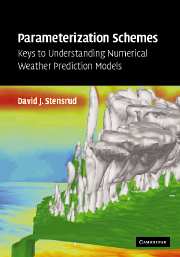Book contents
- Frontmatter
- Contents
- Preface
- List of principal symbols and abbreviations
- 1 Why study parameterization schemes?
- 2 Land surface–atmosphere parameterizations
- 3 Soil–vegetation–atmosphere parameterizations
- 4 Water–atmosphere parameterizations
- 5 Planetary boundary layer and turbulence parameterizations
- 6 Convective parameterizations
- 7 Microphysics parameterizations
- 8 Radiation parameterizations
- 9 Cloud cover and cloudy-sky radiation parameterizations
- 10 Orographic drag parameterizations
- 11 Thoughts on the future
- References
- Index
Preface
Published online by Cambridge University Press: 05 September 2013
- Frontmatter
- Contents
- Preface
- List of principal symbols and abbreviations
- 1 Why study parameterization schemes?
- 2 Land surface–atmosphere parameterizations
- 3 Soil–vegetation–atmosphere parameterizations
- 4 Water–atmosphere parameterizations
- 5 Planetary boundary layer and turbulence parameterizations
- 6 Convective parameterizations
- 7 Microphysics parameterizations
- 8 Radiation parameterizations
- 9 Cloud cover and cloudy-sky radiation parameterizations
- 10 Orographic drag parameterizations
- 11 Thoughts on the future
- References
- Index
Summary
Numerical weather prediction models are playing an ever increasing role in meteorology. Not only are numerical models the foundation of short- and medium-range forecasting efforts, they are key components in studies of global climate change. Gaining insight into the physical processes behind many atmospheric phenomena often rests upon studying the output from numerical models, since observations of sufficient density or quality are not available. This ubiquitous use of numerical models suggests that all aspects of numerical models need to be understood very well by those who use the models or examine their output. However, it is my belief that the meteorological community has stressed an understanding of computational fluid dynamics above an understanding of the subgrid-scale parameterization schemes that play a significant role in determining model behavior. While some may argue in defense that parameterization schemes are fluid and changing all the time, implying that studying them is fruitless, closer inspection reveals that many basic assumptions used in the parameterization of specific processes have changed little over the past decades. The study of parameterization schemes also opens a window that allows one to examine our most fundamental ideas about how these important physical processes function and explore how they behave. Thus, the study of parameterization is a vital and necessary component in the study of numerical weather prediction and deserves far greater attention.
- Type
- Chapter
- Information
- Parameterization SchemesKeys to Understanding Numerical Weather Prediction Models, pp. xi - xivPublisher: Cambridge University PressPrint publication year: 2007

